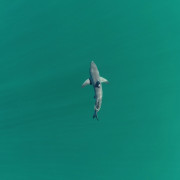- Science News
- Environment
- Unusual Toxoplasma parasite strain killed sea otters and could threaten other marine life
Unusual Toxoplasma parasite strain killed sea otters and could threaten other marine life
by Angharad Brewer Gillham, Frontiers science writer

Image by Mr Laird Henkel, California Department of Fish and Wildlife
Four sea otters that stranded in California were found to have died of an unusually severe form of toxoplasmosis, a disease caused by the microscopic parasite Toxoplasma gondii. Scientists warn that this new strain, never previously reported in aquatic animals, could potentially pose a health threat to other marine wildlife and humans.
Scientists in California are raising the alarm about a newly reported form of toxoplasmosis that kills sea otters and could also infect other animals and people. Although toxoplasmosis is common in sea otters and can sometimes be fatal, this unusual strain appears to be capable of rapidly killing healthy adult otters. This rare strain of Toxoplasma hasn’t been detected on the California coast before, and may be a recent arrival, but scientists are concerned that if it contaminates the marine food chain it could potentially pose a public health risk.
“I have studied Toxoplasma infections in sea otters for 25 years — I have never seen such severe lesions or high parasite numbers,” said Dr Melissa Miller of the California Department of Fish and Wildlife, corresponding author of the study in Frontiers in Marine Science. “We are reporting our preliminary findings to alert others about this concerning condition. Since Toxoplasma can infect any warm-blooded animal, it could also potentially cause disease in animals and humans that share the same environment or food resources, including mussels, clams, oysters, and crabs that are consumed raw or undercooked.”
A common parasite and a rare outcome
Toxoplasma gondii is a common microscopic parasite that is hosted by wild and domestic cats and shed in their feces. Although healthy humans rarely experience symptoms, toxoplasmosis can cause miscarriages and neurological disease. Sea otters are especially vulnerable to Toxoplasma infection because they live near the shoreline where they may be exposed to the parasite’s eggs in rainwater runoff, and they eat marine invertebrates that can concentrate the parasites. The four sea otters described in this study stranded between 2020 and 2022, and all had severe inflammation of their body fat — a condition called steatitis. Severe steatitis is a very unusual finding in sea otters with toxoplasmosis.
“The appearance of this lethal type of Toxoplasma in coastal California is concerning for two main reasons: First, because of potential population health impacts on a threatened species, and second, because this parasite could also affect the health of other animals which are susceptible to Toxoplasma infection,” said study co-author Dr Devinn Sinnott of the University of California Davis (UCD).
Microscopic examination of tissues confirmed Toxoplasma as the cause of death for all four otters. High numbers of the parasites were observed throughout the body except the brain, which is typically one of the major organs affected in sea otters with fatal toxoplasmosis. DNA testing identified a rare strain of Toxoplasma called COUG in all four cases. This strain was first found in 1995 in Canadian mountain lions during surveillance after a nearby outbreak among humans, but the strain of Toxoplasma responsible for the outbreak was never reported. Detection of COUG in sea otters is concerning for the health and recovery of this threatened species.
“This was a complete surprise,” said senior author Dr Karen Shapiro of UCD. “The COUG genotype has never before been described in sea otters, nor anywhere in the California coastal environment or in any other aquatic mammal or bird.”
Download original article (pdf)
Sea otters under threat
All four otters stranded during periods of high coastal rainfall, which means they may have been exposed to Toxoplasma eggs via storm runoff. Although three of the otters stranded near each other, it is unclear whether they were all infected in the same location. It is also unknown how this unusual Toxoplasma strain might affect humans or other animals. At present, no infections with COUG have been reported in humans.
“Because this parasite can infect humans and other animals, we want others to be aware of our findings, quickly recognize cases if they encounter them, and take precautions to prevent infection,” said Miller. “We encourage others to take extra precautions if they observe inflamed systemic fat deposits in sea otters or other marine wildlife.”
With increased surveillance, the COUG strain may be identified in other animals. Researchers also hope to gain a broader understanding of whether some otters are infected with the COUG Toxoplasma strain, but don’t die from it, and many other important questions. If this strain of Toxoplasma is shown to cause significant disease in other animals, it could pose a threat to wildlife conservation efforts and marine food chains, with cascading impacts on human health. There is an urgent need to find out where this rare strain came from and how it could affect sea otters, other animals, and people.
“We still have much to learn,” said Sinnott. “Larger-scale studies are needed to understand the potential impact of infection by the COUG Toxoplasma strain on sea otter populations, how geographically dispersed it is, how it is being introduced into the ocean, and what other animals might be affected.”
REPUBLISHING GUIDELINES: Open access and sharing research is part of Frontiers’ mission. Unless otherwise noted, you can republish articles posted in the Frontiers news site — as long as you include a link back to the original research. Selling the articles is not allowed.







